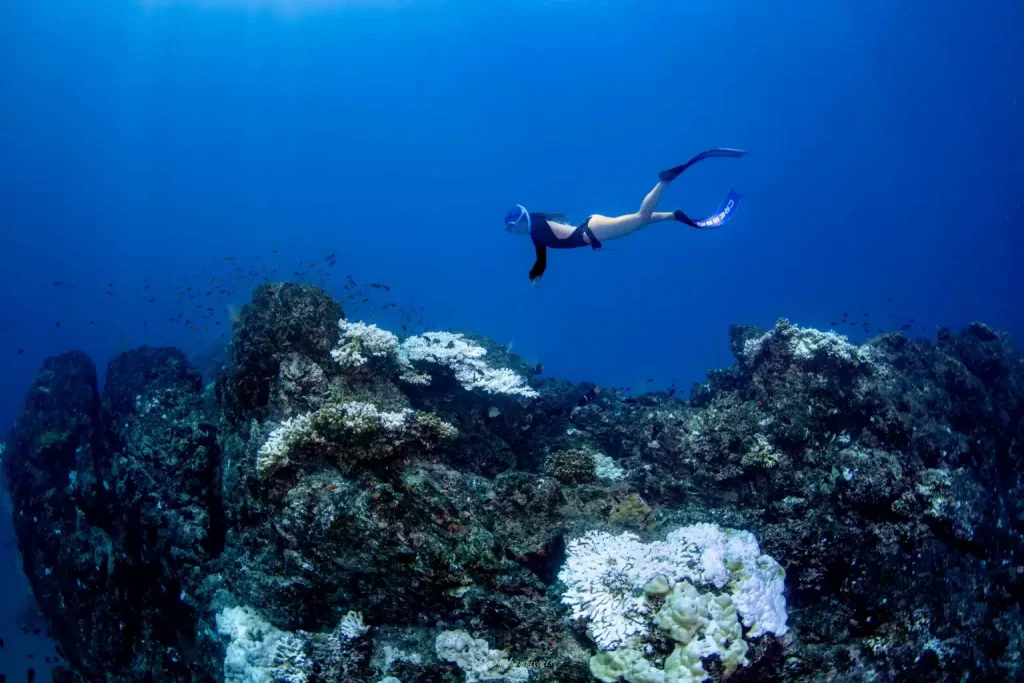El Niño Phenomenon Causes Unprecedented Coral Bleaching in Costa Rica
– The marine conservation nonprofit organization Innoceana raises alarm about the critical state of corals in the Isla del Caño Biological Reserve.
– Extreme ocean temperatures require urgent action: the current conditions of the coral are a call to further protect Costa Rica’s marine ecosystems.
– October 10th, 2023; Ojochal de Osa, Costa Rica — Marine conservation organization Innoceana, which monitors coral indicator colonies on Isla del Caño, Costa Rica, reports that 80% of them are experiencing unprecedented bleaching levels caused by high ocean temperatures associated with the current El Niño Phenomenon.

Bleached coral on Isla del Caño, Osa, Costa Rica. Photograph by Chris Parker.
Since June, Innoceana has regularly monitored sea temperatures to understand and mitigate the impact of the El Niño Phenomenon. One of their HOBO devices has recorded exceptionally high ocean temperatures, reaching a maximum of 31.6°C. “These high temperatures have been observed not only during daylight hours but also in the early morning, when there is normally no sunlight and cooler conditions are expected; the records indicate temperatures of up to 31°C at dawn,” says Kerlyn González, researcher at Innoceana.
The El Niño-Southern Oscillation (ENSO) phenomenon causes unusual warming on the surface of the Pacific Ocean. On this occasion, the planet faces a “Super Niño” due to climate change, which is already altering ocean temperatures. These conditions stress the corals, forcing them to expel the zooxanthellae (microalgae that live within the coral tissue) that sustain them and are vital for their survival, thus causing their bleaching. If this situation continues, the corals will die and become covered in algae. In this way, they will not be able to fulfill the essential role they play in the interconnection with the rest of the species, serving less as a lair for them, forcing them to change their migratory routes due to the change in food availability. It should be noted that numerous species such as sharks, whales, turtles, rays and many other migratory species pass through Caño Island.

“We have been studying the corals of Isla del Caño since 2018, creating 3D models, even giving them names; we never imagined that in 2023 they would all be white, it’s truly disheartening, but at the same time, this reinforces our mission,” mentions Carlos Mallo Molina, CEO and Founder of Innoceana. In addition to temperature, visibility, and turbidity measurements, the organization has continued to take water quality samples at georeferenced locations. The organization also continues to create 3D coral models to monitor bleaching and mortality events.
Although bleached corals are not dead but stressed, they could deteriorate within weeks if ocean temperatures do not return to normal. Sometimes, corals in this state can survive one or two months but are more susceptible to diseases since, lacking zooxanthellae, they are extremely vulnerable. It is crucial to raise awareness among the population about how human practices affect marine ecosystems. Urgent adoption of pro-environmental behaviors and support for organizations promoting them is needed to mitigate the effects of climate change and the El Niño Phenomenon.
About Innoceana:
Innoceana is a global nonprofit marine conservation organization that works to preserve the ocean for future generations by empowering coastal communities through access to education and innovative tools.
